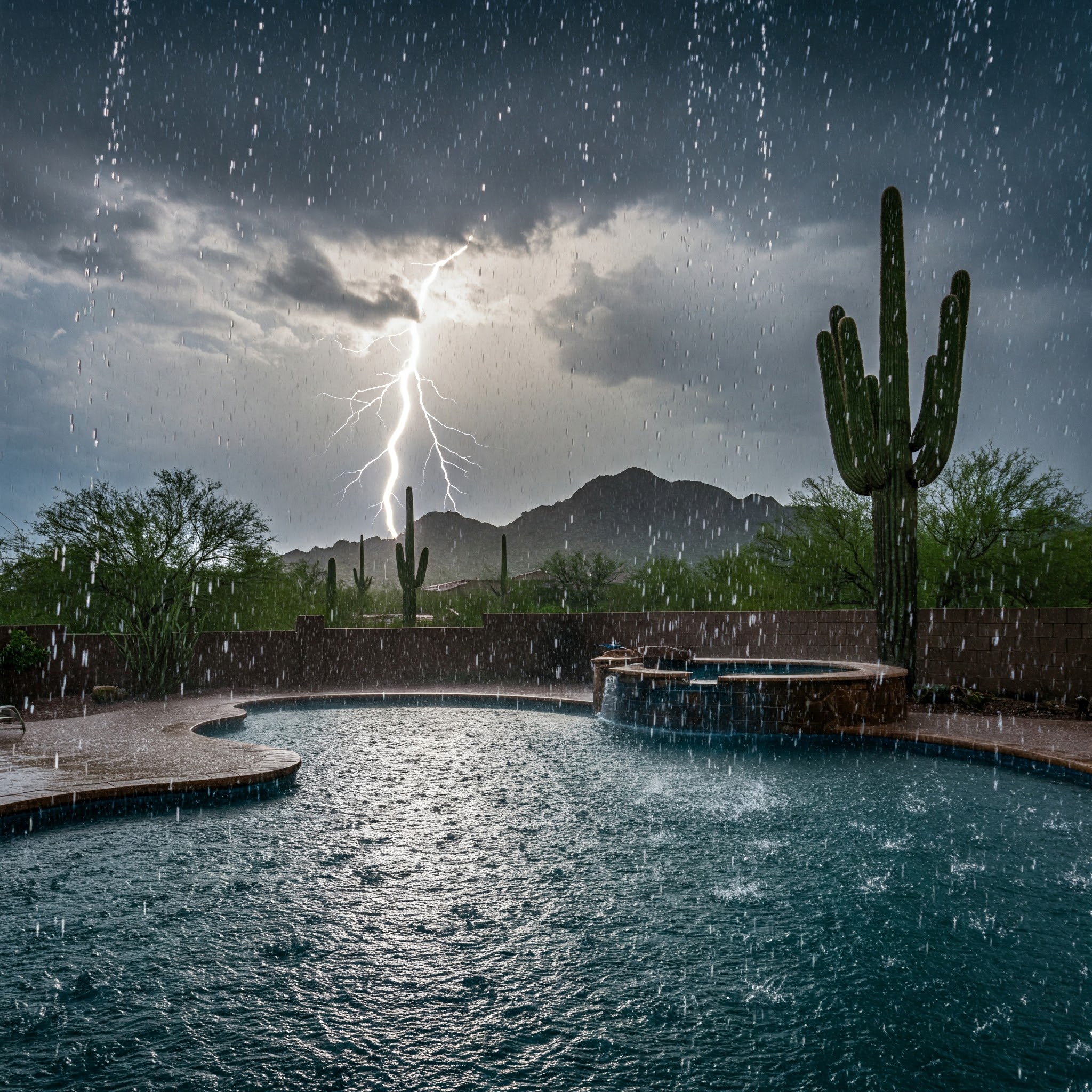Monsoon Pool Care: Protecting Your Paradise in Verrado
May 7, 2025 6:47:54 PM

Monsoon Pool Care: Protecting Your Paradise in Verrado
The Arizona monsoon season. We know it well here in Verrado – the dramatic skies, the promise of much-needed rain, and unfortunately, the potential chaos it can unleash on our backyard swimming pools. While haboobs bring dust, monsoon downpours present their own unique challenges: overflowing water, a barrage of debris, and water chemistry that can go haywire in a hurry.
But don't let the thought of murky water and extra work dampen your spirits! With a little know-how and proactive care, you can protect your pool and ensure it remains your personal paradise, even when the monsoon rolls in.
Before the Storm: Prepping Your Pool for the Onslaught
A little preparation can go a long way in minimizing the impact of a monsoon storm:
- Balance Your Water Chemistry: This is crucial. Ensure your pH, alkalinity, cyanuric acid (CYA) and chlorine levels are within their ideal ranges. Properly balanced water is better equipped to handle the contaminants rain can introduce. Consider adding boric acid as an additional buffer to minimize pH changes.
- Clean the Pool: Skim leaves, trim overhanging branches, and clear the deck of loose items like pool toys, lightweight furniture, and unsecured umbrellas. The less debris around the pool, the less that can be blown in.
- Check Your Filter: Ensure your filter is clean and functioning optimally. A clean filter will be much more effective at handling the increased load of dirt and debris that a storm can bring. If it's been a while, clean or backwash your sand or DE filter before the storm. Cartridge filters should be cleaned twice each year.
- Secure Equipment (Cautiously): If you have a pool cover, the decision to use it can be tricky. While it might seem like a good idea to keep debris out, strong monsoon winds can damage covers or even lift them, dumping everything on top into the pool anyway. If you do use a cover, ensure it’s securely anchored. More importantly, consider turning off the breakers to your pool equipment if severe electrical storms are predicted to protect against power surges.
- DO NOT Pre-Drain Your Pool: It might be tempting to lower the water level in anticipation of heavy rain, but this can be risky. If you drain too much and the rain isn't as heavy as expected, your skimmers might run dry, potentially damaging your pump. It's better to manage excess water after the storm.
- Ensure Proper Drainage: Check that deck drains and yard drainage systems are clear and can handle a heavy flow of water away from your pool and equipment.
- After the Storm: Recovery and Restoration
Once the monsoon has passed, it's time to assess and act:
- Safety First! Before doing any work, ensure the storm has completely passed and there's no risk of lightning. Check for any downed power lines or visible damage to electrical equipment. If you suspect any electrical damage, call a qualified professional immediately.
- Remove Large Debris: Carefully remove any large branches, leaves, and other debris from the pool surface and skimmer baskets.
- Clean Skimmer and Pump Baskets: These will likely be full. Cleaning them out promptly is essential for restoring proper circulation and filtration.
- Skim, Brush, and Vacuum: Remove all visible surface debris with a net. Brush the pool walls and floor to loosen dirt and smaller particles. Vacuum the pool thoroughly if you do not have an automatic cleaner. If there's a very large amount of fine debris, you might consider vacuuming to "waste" (if your system allows) to bypass the filter initially.
- Check and Adjust Water Level: If the heavy rain has caused your pool to overflow or the water level is too high (above the skimmer opening), you'll need to drain the excess water. Use your filter pump (if it has a "waste" setting) or a submersible pump. Be careful not to lower the water level below the skimmer.
- Test Your Water Chemistry (Crucial!): This is where the real work begins. Rainwater is typically acidic and can significantly lower your pool's pH and alkalinity. It also dilutes your chlorine and other sanitizers, calcium hardness, and CYA (stabilizer).
- Test all key levels: pH, total alkalinity, free chlorine, calcium hardness, and (CYA).
- Adjust Alkalinity First: Bring your total alkalinity to 90 ppm. This will help stabilize your pH.
- Balance pH: Adjust your pH to 7.5.
- Shock Your Pool: This is almost always necessary after a significant rainfall. Rain washes in organic contaminants, pollutants, and algae spores. Shocking the pool with a high dose of chlorine will kill bacteria, break down contaminants, and help prevent algae blooms. Follow the product instructions carefully.
- Adjust Chlorine, Calcium, Boric Acid, and CYA: Once the shock has done its job and chlorine levels have returned to a safe swimming range (7.5% ppm of your CYA level for traditional chlorine pools and 5% ppm of your CYA level for salt water pools), re-test and adjust your free chlorine, calcium hardness (350 ppm), and cyanuric acid (30-50 ppm for outdoor pools) as needed. Borate should be at 50 ppm if used.
- Run Your Filter: After cleaning and chemical adjustments, run your filter system continuously for at least 24 hours, or longer if needed, to help clear the water and circulate the chemicals.
- Clean Your Filter Again: After the initial cleanup and extended run time, your filter will have captured a lot of material. Clean or backwash it again to ensure it's ready for normal operation.
- Monitor Closely: Keep an eye on your pool water for the next few days. Test the chemistry daily and make small adjustments as needed until everything is stable and clear.
Ongoing Monsoon Season Vigilance in Buckeye:
- Be Prepared to Repeat: Monsoon season isn't a one-storm event. Stay vigilant and be ready to repeat these steps after each significant downpour.
- Consider Professional Help: If the cleanup seems overwhelming, or if your pool develops persistent algae or cloudiness, don't hesitate to call your local Buckeye pool service professionals. We have the expertise and equipment to get your pool back in shape quickly.
Living in Verrado means embracing the unique beauty and challenges of our desert climate. With these monsoon pool care tips, you can confidently protect your backyard oasis and keep it sparkling clean and inviting, ready for you to enjoy all season long – come rain or shine!

